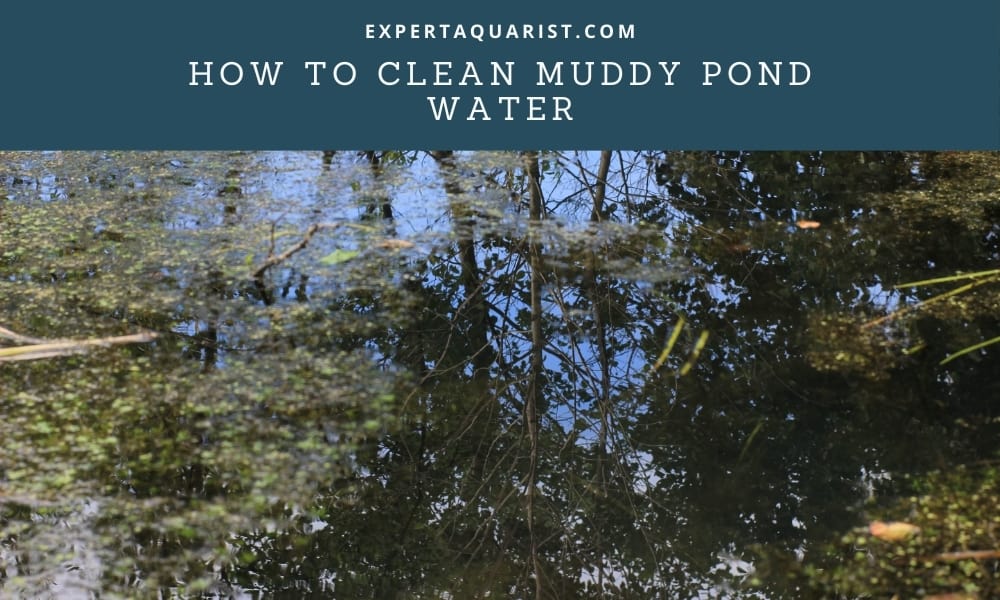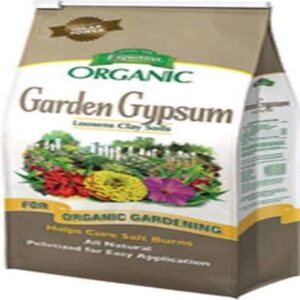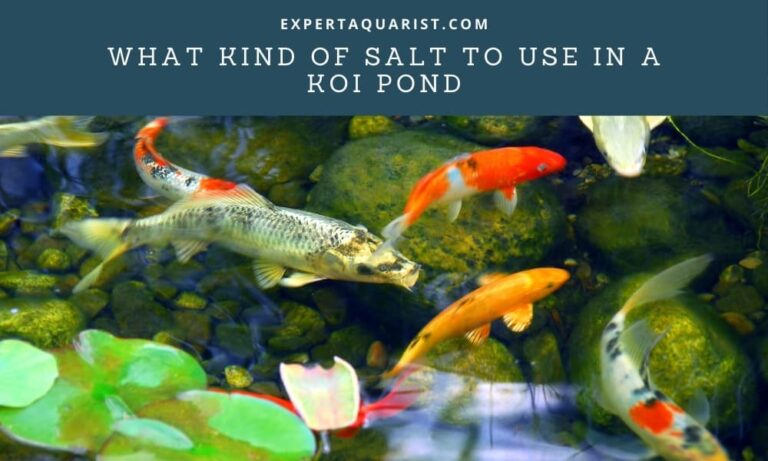Muddy water is a big obstacle in your road to backyard aestheticism. It looks tacky, dirty, and unhygienic. Having a muddy pond kills off the vibe of your entire backyard setting and could also risk the health of the pond inhabitants.
In order to maintain the high quality of your pond, you should know how to clean muddy pond water.
There are quite a few ways you can clean muddy pond water. The simplest way to do it would be to use filters and manually removing debris so that it doesn’t accumulate. If it’s not enough, you’d have to use chemicals like alum or gypsum. Having beneficial bacteria also helps!
Interested to know more about cleaning muddy pond water? Head down below…

Methods of Cleaning Muddy Pond Water
There are several methods to clean muddy pond water. We’re discussing some efficient pond cleaning methods here. You can use one of these methods carefully to remove muddy water from your pond.
1. Applying Gypsum

You can use agricultural gypsum to eliminate the turbidity caused by suspended clay particles. Besides, it won’t cause any harm to the fish in your pond. So you won’t have to worry about their safety while using it.
Gypsum will engage the clay particles and make them settle. You should choose a quiet day to spread gypsum over the pond surface because water movements originating from the wind will stop these clay particles from settling quickly.
You can apply a dose of 250-500 pounds per acre-foot of water and wait for four weeks to determine if additional gypsum is required.
2. Adding Alum
You can also remove clay turbidity from your pond by using Alum. In most cases, it won’t take more than a couple of hours. Apply a dose of Alum 225 pounds per acre-foot of water.
In this case, you’ll have to wait for just one day to determine whether additional alum will be needed. That’s why many people consider this method as the most efficient way to clear turbidity.
However, using excessive amounts of Alum can be dangerous for the aquatic lives in your pond as it creates a reaction that could increase the acidity level in the water.
So you should check the alkalinity and the pH level in the water before spraying Alum over the pond surface. You must ensure that the Alkalinity is above 100 mg/l and the pH is higher than 7.0. Please put on safety clothing to apply it to the pond water.
3. Introducing Beneficial Bacteria

Beneficial Bacteria is another good option to clear your pond water. It will consume dead leaves, rotten fish food, animal feces, and other decaying organic matters from the pond’s lower sediment.
Spray 10 pounds per acre-foot of water. You’ll have to continue this application weekly for four weeks to improve the quality of your pond water. It will completely eradicate mud and waste materials from your pond.
4. Applying Bales of Hay
Applying bales of hay is also a solution to the problem of muddy pond water. But stay away from using the hays that are freshly cut as it could bring fatal results for your pond fishes.
You should also refrain yourself from using excessive amounts of bales. Spread two bales of hay per surface acre in your pond.
5. Changing pond water
Instead of cleaning the pond water, it is also safe to change 30% of your pond’s total water volume per week. It’s a slow process, but it won’t cause any harm to your fish or plants. By continuing this process every week, you’ll be able to clear your pond within a month.
6. Using a pond skimmer
You can use a pond skimmer to clean your pond in a much faster way. It will get rid of the debris from your pond. It would also be wise to apply a pond net above the pond’s surface to collect fallen leaves and tiny sticks. It will prevent them from decaying in the lower section of the pond.
Understanding the causes of muddy Pond Water
You already know the methods of cleaning the muddy pond water, but you need to understand what causes your water to turn muddy or turbid so that you can stop the water from being dirty.
Turbidity can result from several different sources:
(a) Clay
Suspended clay particles can cause turbidity in your pond water. These particles repel each other as they are negatively charged. They stay unsettled after entering into a pond from the sides and force the water to remain turbid.
(b) Fish
Feeding habits of fish such as bullheads and carp can turn your water muddy as they tend to feed themselves on the lower side of the pond. Such activities make bottom sediment suspended. Crayfish can also cause disturbances in your pond bottom with their burrowing habits.
You should replace these species with predatory fish such as Largemouth Bass, Bluegill, Fathead Minnow, Channel Catfish.
(c) Rainfall
Heavy rainfall creates access for mud and clay to the pond. This is a severe issue in an area where it rains all the time. Soil erosion on the shore of a river caused by wind or waves also brings a similar outcome.
(d) Tannin
Tannin build-up, originating from decayed plants also causes brown pond water. Tea manufacturers use tannin, which is found on various plant species, as an essential ingredient to make their teas brown in western countries.
(e) Lack of Filtration
Lack of proper filtration can be a cause of muddy pond water. The pond filter must match the size of your pond. Otherwise, it won’t filter out the clay particles from the deepest section of the pond.
(f) Waste
You’ll find debris in a pond almost all the time; it is a natural thing. What is unnatural is you being negligent about it. You can’t let it accumulate. The piled-up debris will become waste, and that sludge goes on to make the water muddy.
Alongside debris, uneaten fish food is another source of this waste, which is why you should avoid overfeeding your fish.
(g) Algae
A little bit of algae might look cute to you, but when they huddle together and build a colony, they’re up to no good. You’ll see the first sign of caution is when the pond water starts to become greenish. From there, it’ll keep going downhill.
The reason behind this change in color is algae; they compromise the water quality and texture. Even after death, they’ll give you headaches. As they turn into sludge and excess sludge is bad news for your pond.
(h) Livestock access
Allowing livestock to roam in your pond is not a good idea as they also. Even by doing something trivial like drinking from the pond or going in for a swim, they will still play their part in making the water muddy.
While a little bit of manure is acceptable, a lot of it is just a buildup of waste and toxicity.
Please take care of your pond and be mindful of these catalysts.
Problems of muddy pond water
1. Less food for fish
Muddy pond water makes your fish less productive. It also causes low sunlight penetration and reduces fish food availability as a result as plants are not able to undergo photosynthesis like normal. Fishes are bound to find themselves in an unhealthy condition if the water is muddy.
2. Reduced number of planktons
Planktons are an important entity that keeps the ecology of the pond stable. A muddy pond doesn’t generate much plankton, therefore ruins the balance of nature.
3. Lowered DO
DO stands for dissolved oxygen, and it is a vital piece for the pond. To put it simply, you need to have a certain amount of DO in your pond to keep it healthy.
Muddy water means less sunlight inside the pond so the plants are not able to produce oxygen as a byproduct of photosynthesis. You’re essentially calling in trouble if you let this happen.
4. Fish suffocation
Having a muddy pond increases suffocation inside the pond, especially if you have fish babies. Lowered DO means fish have to compete for the breath of air. If you see fish coming out to the surface, then please do something immediately because they’re uncomfortable.
Albeit an extreme occurrence but further negligence could lead to the death of fishes in some circumstances.
If you don’t want your pond to face this fate, then please take this matter seriously.
Keep your pond sparkly!
A clean pond does not only maintain your backyard’s high visual standards; it’s soothing for your eyes too. After a hectic day, coming back to the backyard and watching crystal clear pond water is miles better than seeing a muddy one.
So please keep your pond clean. Since you know how to clean muddy pond water, you’ll find yourself comfortable in these methods and smoothly apply them to ensure your pond’s cleanliness.
Remember to observe your pond regularly, okay?






